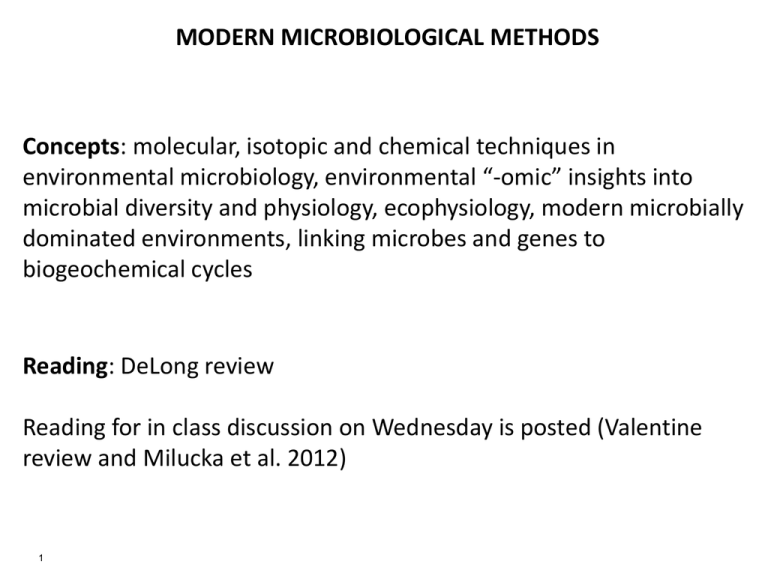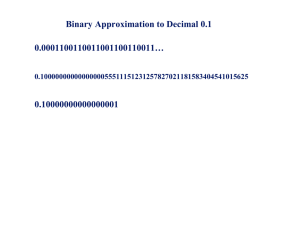
MODERN MICROBIOLOGICAL METHODS
Concepts: molecular, isotopic and chemical techniques in
environmental microbiology, environmental “-omic” insights into
microbial diversity and physiology, ecophysiology, modern microbially
dominated environments, linking microbes and genes to
biogeochemical cycles
Reading: DeLong review
Reading for in class discussion on Wednesday is posted (Valentine
review and Milucka et al. 2012)
1
EXAMPLES OF MODERN MICROBIALLY-DOMINATED
ENVIRONMENTS
Courtesy of NASA. Photograph in the public domain.
Courtesy of National Oceanic and Atmospheric
Administration. Photograph in the public domain.
2
Courtesy of National Park Service.
Photograph in the public domain.
Courtesy of Mike Baird on flickr. CC-BY.
Courtesy of NASA. Photograph in the public domain.
EXAMPLES OF MODERN MICROBIALLY-DOMINATED
ENVIRONMENTS
u
Courtesy of Robert Young on flickr. CC-BY.
Courtesy of Ebedgert on wikipedia.
Photograph is in the public domain.
.
Kessler et al., 2011
© American Association for the Advancement of Science.
All rights reserved. This content is excluded from our
Creative Commons license. For more information, see
http://ocw.mit.edu/help/faq-fair-use/. Source: Kessler,
J. D. et al. "A Persistent Oxygen Anomaly Reveals the
Fate of Spilled Methane in the Deep Gulf of Mexico."
Science 331, no. 6015 (2011): 312-5.
.
Source: http://iridl.ldeo.columbia.edu/, IRI/LDEO Climate Data Library, Columbia
3
EXAMPLES OF MODERN MICROBIALLY-DOMINATED
ENVIRONMENTS
Courtesy of NASA. Image in the public domain.
Courtesy of National Oceanic and Atmospheric Administration. Photograph in the public domain.
4
http://earthobservatory.nasa.gov/GlobalMaps/view.php?d1=MY1DMM_CHLORA&d2=MOD17A2_M_PSN#
Chlorophyll map
NPP map
5
Courtesy of NASA Earth Observatory. Figures in the public domain.
6
Source: Whitman, William B., David C. Coleman, et al. "Prokaryotes: the Unseen
Majority."Proceedings of the National Academy of Sciences 95, no. 12 (1998):
6578-83. Copyright National Academy of Sciences, U.S.A.
Step 0: geochemical observations
7
© American Association for the Advancement of Science. All rights reserved. This content is excluded
from our Creative Commons license. For more information, see http://ocw.mit.edu/help/faq-fair-use/.
Source: D'Hondt, S. et al. "Distributions of Microbial Activities in Deep Subseafloor Sediments."
Science 306, no. 5705 (2004): 2216-21.
Step 1: microscopy and morphological characterization
Courtesy of MDPI. CC-BY. Sou rce: Figure 1C of Sim, M. S. et al. "Oxygen-Depend ent Morphogenesi s
of Modern Clumped Photosynthetic Mats and Implications for the Archean Stromatolite Record."
Geosciences 2, no. 4 (2012): 235-59.
8
Step 2: enrichment, cultivation and isolation
http://www.jlindquist.net/generalmicro/102dil3.html
Courtesy of John Lindquist. Used with permission.
The Most Probable Number Method
9
Step 3: amplification of 16s rRNA sequences, clone libraries, DGGE
© American Association for the Advancement of Science. All rights reserved. This content is excluded
from our Creative Commons license. For more information, see http://ocw.mit.edu/help/faq-fair-use/.
Source: Kessler, J.D. et al. "A Persistent Oxygen Anomaly Reveals the Fate of Spilled Methane in the
.
Deep Gulf of Mexico." Science 331, no. 6015 (2011): 312-5.
10
(Kessler et al., 2011)
Step 4: fluorescent in situ hybridization (16s rRNA sequences)
Courtesy of Nature Publishing Group. Used with permission. Source: Karner, M.B et al. "Archaeal
Dominance in the Mesopelagic Zone of the Pacific Ocean." Nature 409, no. 6819 (2001): 507-10.
11
SAR11 – UBIQUITOUS MARINE BACTERIUM
12
Courtesy of Nature Publishing Group. Used with permission. Source: Morris, R.M. et al. "SAR11 Clade
Dominates Ocean Surface Bacterioplankton Communities." Nature 420, no. 6917 (2002): 806-10.
Step 5: sequencing of environmental 16s rRNA + more
13
© American Association for the Advancement of Science. All rights reserved. This content is excluded
from our Creative Commons license. For more information, see http://ocw.mit.edu/help/faq-fair-use/.
Source: Béja, O. et al. "Bacterial Rhodopsin: Evidence for a New Type of Phototrophy in the Sea."
Science 289, no. 5486 (2000): 1902-6.
Step 6: genome sequencing
Courtesy of Nature Publishing Group. Used with permission. Source: Tripp, H. J. et al. "SAR11 Marine
Bacteria Require Exogenous Reduced Sulphur for Growth." Nature 452, no. 7188 (2008): 741-4.
14
Step 7: isolation (if lucky)
Courtesy of Nature Publishing Group. Used with permission. Source: Rappé, M.S. et al. "Cultivation of
the Ubiquitous SAR11 Marine Bacterioplankton Clade." Nature 418, no. 6898 (2002): 630-3.
15
Courtesy of Nature Publishing Group. Used with permission. Source: Selje, N. et al. "A Newly
Discovered Roseobacter Cluster in Temperate and Polar Oceans." Nature 427, no. 6973 (2004):
445-8.
16
Step 8: physiological and genomic diversity
© Annual Reviews. All rights reserved. This content is excluded from our Creative
Commons license. For more information, see http://ocw.mit.edu/help/faq-fair-use/.
Source: Wagner-Döbler, Irene, and Hanno Biebl. "Environmental Biology of the
Marine Roseobacter Lineage." Annu. Rev. Microbiol. 60 (2006): 255-80.
17
18
Courtesy of Nature Publishing Group. Used with permission. Source: Figure 2 from Kolber, Z.S. et al.
"Bacterial Photosynthesis in Surface Waters of the Open Ocean." Nature 407, no. 6801 (2000): 177-9.
19
© Annual Reviews. All rights reserved. This content is excluded from our Creative
Commons license. For more information, see http://ocw.mit.edu/help/faq-fair-use/.
Source: Wagner-Döbler, Irene, and Hanno Biebl. "Environmental Biology of the
Marine Roseobacter Lineage." Annu. Rev. Microbiol. 60 (2006): 255-80.
20
Courtesy of Nature Publishing Group. Used with permission. Source: Moore, L. R et al. "Physiology and
Molecular Phylogeny of Coexisting Prochlorococcus Ecotypes." Nature 393, no. 6684 (1998): 464-7.
Stable core genome and variable genomic islands: phenotypic differences
© American Association for the Advancement of Science. All rights reserved. This content is excluded
from our Creative Commons license. For more information, see http://ocw.mit.edu/help/faq-fair-use/.
Source: Coleman, M.L. et al. "Genomic Islands and the Ecology and Evolution of Prochlorococcus."
Science 311, no. 5768 (2006): 1768-70.
21
Step 9: diversity/transcription of individual genes
22
© Springer Science+Business Media. All rights reserved. This content is excluded from our Creative
Commons license. For more information, see http://ocw.mit.edu/help/faq-fair-use/.
Source: Chin, K. et al. "Quantifying Expression of a Dissimilatory (bi)Sulfite Reductase Gene in
Petroleum-Contaminated Marine Harbor Sediments." Microbial Ecology 55, no. 3 (2008): 489-99.
23
Courtesy of Nature Publishing Group. Used with permission. Source: Zehr, J.P. et al. "Unicellular
Cyanobacteria fix N2 in the Subtropical North Pacific Ocean." Nature 412, no. 6847 (2001): 635-8.
Step 10: diversity/transcription of the whole genome
24
Courtesy of International Society for Microbial Ecology. Used with permission. Source: Shi, T. et al.
"Genome-Wide Analysis of Diel Gene Expression in the Unicellular N2-fixing Cyanobacterium
Crocosphaera Watsonii WH 8501." The ISME Journal 4, no. 5 (2010): 621-32.
Step 11: environmental transcriptomics
25
Courtesy of Nature Publishing Group. Used with permission. Source: DeLong, E. F. "The
Microbial Ocean from Genomes to Biomes." Nature 459, no. 7244 (2009): 200-6.
Step 12: proteomics
26
Courtesy of National Academy of Sciences and the authors. Used with permission. Source: Saito, M. A.
et al. "Iron Conservation by Reduction of Metalloenzyme inventories in the Marine Diazotroph
Crocosphaera Watsonii." Proceedings of the National Academy of Sciences 108, no. 6 (2011): 2184-9.
© Blackwell Publishing Ltd. All rights reserved. This content is excluded from our Creative
Commons license. For more information, see http://ocw.mit.edu/help/faq-fair-use/.
Source: Bosak, T. et al. "Cyanobacterial Diversity and Activity in Modern Conical
Microbialites." Geobiology 10, no. 5 (2012): 384-401.
27
cone
mat
10 µm
CONE
MAT
60 µm
30 µm
100 µm
20 μm
50 μm
1
120 μm
2
1
2
3
100 μm
140 μm
4
3
120 μm
220 μm 4
330 μm
350 μm
520 μm
28
25 µm
15 µm
© Blackwell Publishing Ltd. All rights reserved. This content is excluded from our Creative
Commons license. For more information, see http://ocw.mit.edu/help/faq-fair-use/.
Source: Bosak, T. et al. "Cyanobacterial Diversity and Activity in Modern Conical
Microbialites." Geobiology 10, no. 5 (2012): 384-401.
29
MIT OpenCourseWare
http://ocw.mit.edu
12.007 Geobiology
Spring 2013
For information about citing these materials or our Terms of Use, visit: http://ocw.mit.edu/terms.


